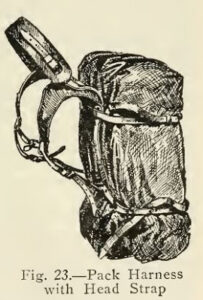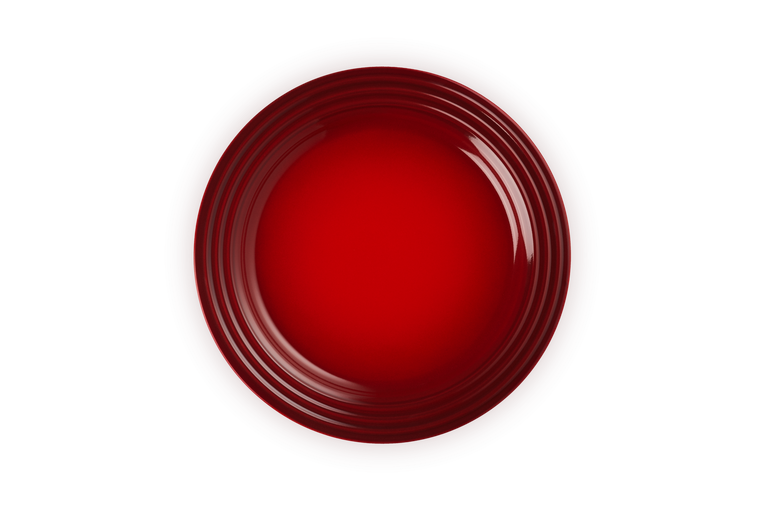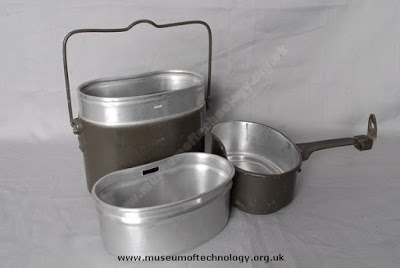
I was reading some pretty useful advice on how to collect water while minimizing the chance of sediment and other large materials.
Hold the mouth of your bottle a fist-width below the surface to avoid floating debris (and mosquito larvae!). Hold it off the bottom to avoid stirring up silt. If the water is flowing, point the nozzle downstream to reduce the change of solids being washed in.
Cover the water bottle neck with a section of bandanna to filter water going in. Use a clove hitch or slip knot to secure the bandanna. This also puts a safety lead on your bottle to avoid loss!
Cover your canteen cup with another part of the bandanna and pour the water in the bottle through the bandanna into your cup to filter it a second time. Pour a little of this water into the bottle, to rinse out any particles that got in. Now sterilize your water.
The flaw in these instructions is that most water bottles are at least a quart or a litre, and canteen cups generally about half that! Biggest that springs to mind is the British Crusader MK.II cup at 800 mls.
I will come back to this topic presently.
After you have filtered your water, you still need to sterilize/pasteurize it. One of the most effective ways to ensure water is safe is to bring it to a rolling boil. Many foods you will encounter in a survival scenario will need cooking to make them safe or more palatable.
While there are ways to cook and even boil water without a metal vessel, life is a lot easier with one!
What Is Wrong with the Canteen Cup?
In his recommendations for SERE, Robert DePugh notes “Such cooking as may be essential can be done in the canteen cup.”
Many preppers and soldiers wishing to lighter their load are of a similar opinion.
The catch is that as they come, most canteen cups are wanting in certain respects.
The most obvious of these is most lack a lid. Lids save fuel and time. They keep bugs, dirt, dust and rain out of your food. In an escape and evasion situation, a lid may reduce tell-tale cooking odours.
Most canteen cups also require a stove. If you have to cook over a fire, you will need to jerry-rig some form of pot-support, or wait until the fire dies down to coals.
Not only do the side handles get hot, but your hand comes dangerously close to the fire.
How simpler things would be if your cooking vessel had a bail handle so you could hang it over a heat source!
It is possible to make or buy lids for your canteen cup. Similarly, there are a number of ways to add a bail handle.
I currently have three canteen cups sitting on the work table awaiting conversion. Each month I do not seem to have either the money or the time to gather the necessary tools and materials.
There is an obvious need for a low bulk cooking vessel. Can we do better than a canteen cup?
Suppose I told you that there is a superior alternative that is widely available and ready to use off the shelf, complete with bail handle and lid?
“European” Mess Kits
Instead of a canteen cup, why not carry a mess kit?
Specifically, I am suggesting the sort of military mess kit that looks like a binocular case, being either oval or kidney shaped in cross-section. I have seen these called “European” mess kits, although the Chinese and Imperial Japanese Army seem to have used the design too.
The bottom portion of the kit is a billy, with a bail handle. The upper part typically is a small pan with a side handle. This pan also serves as a lid during cooking or transport.
Many of you will have a passing familiarity with these mess kits. Their potential may have escaped you.
For a camping trip, I typically prefer a more versatile cooking outfit.
For a bug-out bag, where most of your cooking will simply be boiling or reheating, a mess kit of this configuration is ideal.
I have used my Swedish set for winter day hikes, since it fits nicely inside a daysac. With the snow thick on the ground, I have paused to cook myself some hot noodles.

The familiar British and American designs of mess kit are actually atypical. The British Army used a “D-shaped” mess kit during the First World War and back through most of the nineteenth century.
The armies of most nations have used “binocular case” mess kits at one time or another. Many nations continue to use this design.
Most of the kits of this type available are described as German or Austrian, or “M31 pattern”. Do not confuse these with the pair of cups that fit outside of the German Army M59 water canteen.
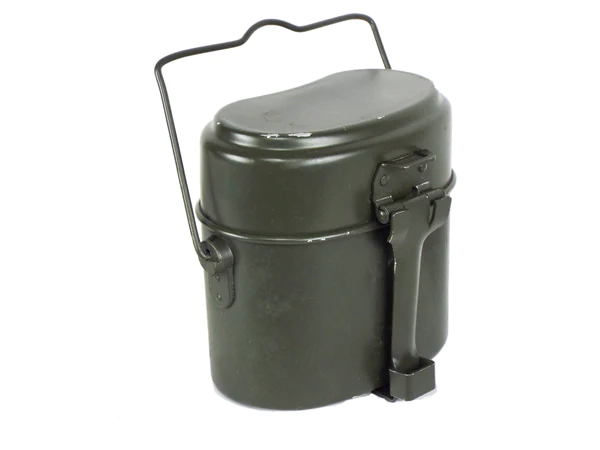
The more recent Bundeswehr mess kit variants are to be preferred, since these have handles that can be locked upright or out to one side, away from the flames.
The German kit (and some other examples) includes a third part which is a metal bowl/insert. The hook at the end of the lid handle engages a slot in the bowl, so the two may be carried together, or the pair balanced across the top of the billy.
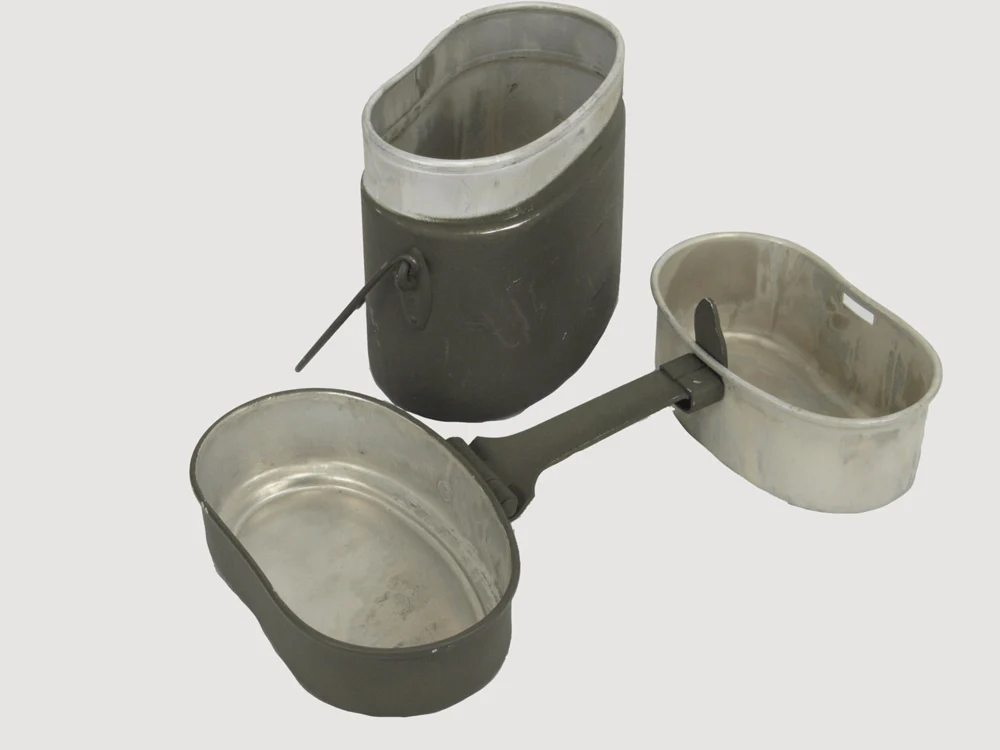
There are also Chinese manufactured kits that appear to be the same design as the German. These appear to be of new manufacture, rather than military surplus.
Russian, Romanian, Hungarian and Polish surplus examples are also stocked by some suppliers.
At time of writing, prices are comparable to those of many metal canteen cups that come without lids.
Most of these kits must be brought army surplus, so you roll the dice on condition and actual design. If you want something unused, the Chinese-made copies of the German sets are an option.
To these options, I will add the Swedish M40 AL/M44 mess kit set that includes a windshield and spirit burner.
The Swedish kits have become more widely known and popular in recent years. Prices have skyrocketed since I bought mine, decades ago. I am not sure if these are still issued or in production. One company makes a stainless steel copy of the Swedish kit. An aluminium version with a non-stick coating would be very welcome.
The Case Against:
• Let us get one objection to this idea out of the way! This is that a mess kit will not fit neatly around a water bottle in a belt pouch like a canteen cup will.
Firstly, while carrying some water on your person is prudent, you should minimize unnecessary weight. To my mind it is more sensible to carry a canteen cup or equivalent in your pack, not on your belt.
Secondly, water is better carried in a bladder than a bottle. Water in a bottle may slosh around, and that noise may give you away while hunting, nature-watching or in a tactical situation. Excess airspace is seldom a problem with a bladder.
If you do carry water in a bottle, repurposed soda bottles work fine, and are lighter and cheaper than military style rigid water bottles. Soda bottles are much more flexible than thicker bottles. If the contents of a bottle freeze, the ice can be broken up without damaging the bottle.
In sub-zero conditions, carry your water bottles and bladders in the warmest part of your pack. Invert them so that the drinking tube or cap is lowest. Ice floats, so the lowest part of a container will be the last to freeze solid. Ice expands, so leave some airspace within a container if freezing is likely.
If you expect freezing temperatures overnight, pour some of your water into a cooking vessel. Ice in a pot is easier to melt than snow or ice within a bottle.
In very cold conditions, when you heat water, use what you do not use to top-up/warm-up your water containers.
If you do not carry a canteen cup on your belt, and you do not carry a military canteen, it does not matter that your cooking vessel will not nest around a canteen!
• Second objection is that most of these vessels have bare aluminium interiors. If you wade through the media sensationalism, groundless opinion and scare-mongering, you will find the evidence on possible health risks of using aluminium cookware is still inconclusive.
The surface of a cooking vessel is actually aluminium oxide, which serves as a protective coating. Prudence suggests that if you avoid cooking anything particularly acidic in an aluminium vessel, avoid prolonged cooking, or a combination of the two, you should be safe. If you use a very abrasive cleaner on your cookware, leave a short interval for the oxide coating to reform.
For a cooking vessel in an emergency kit, or one that is only used occasionally for trips out, bare aluminium is a legitimate choice. Remember that actual cooking in a survival or E&E scenario will be fairly basic and unsophisticated. Mainly just heating and boiling.
• Third objection to the mess kit is that it is larger than a canteen cup.
In a survival or E&E situation, most of your food will be from plants. These tend to be low in calories, so you will need to eat a lot of them. Bear in mind that in a survival situation, you may have to also cook for someone other than yourself. A cooking vessel larger than a canteen cup may be an advantage.
As my introduction has suggested, being able to heat treat more than half a litre of water at once is useful.
While it has more bulk, a European-style mess kit is still compact enough to fit in most daysacs. The interior space of a mess kit may be packed with food and other useful items, so effectively becomes zero bulk.
Generally, a mess kit is heavier than a canteen cup too, but bear in mind this is for two or three cooking vessels rather than a single one. My German mess kit is 400 g. 350 g if the metal bowl/insert is left at home. My Swedish five piece kit is 875 g, including windshield, burner and empty fuel bottle. Billy and lid on their own are 450 g.
The billy of my Swedish mess kit has a capacity of about 1.3 litres. The equivalent part of the M31 is 1.5 litres. It includes a measuring indent each 500 mls. Oddly, the German kit looks slightly smaller than the Swedish. Both kits can boil more than a litre of water to sterilize it.
For completeness, the lid of my Swedish Kit holds 550 mls. Both the lid and the insert/bowl of the German kit hold 400 mls each.
My Polish mess kit resembles the German model but is smaller. There is no insert and the bail handle lacks any locking mechanism. The billy has a capacity of one litre and the lid 500 mls. It masses 300 g. There is a measuring indent at half a litre.
One odd quirk of the Polish set is that it is top heavy when empty.

To put these masses and volumes in context, my 650 ml Crusader Mk 1 cup alone is 250 g!
Note that masses and volumes on this page were measured using items I personally own. Figures may differ from those given by vendors.
The Case For:
To my mind, it is not a billy if it does not have a bail handle. The bail handle is a simple feature that makes a camping cooking vessel infinitely more practical and versatile.
The bail handle of a billy lets you hang it over a fire. If your stove is a bit wobbly, you can use a tripod or crane for added security of your vessel.
In a previous post, we looked at how useful a bucket might be. A billy is essentially a bucket you can cook in. It may be used to fetch water or to gather berries. You can use it to transport a meal, even while the food is still hot. If you expect rain, leave it outside your shelter to collect fresh water.
An effective cooking vessel should be one of the foundations of your bug-out bag, 72-hour pack or survival kit.
The capacity of a European mess kit makes it more useful and versatile than a canteen cup, yet still compact enough to fit inside a relatively modest capacity bag. Or, looked at another way, it leaves room for something else you will need.
The lid of a European mess kit serves as a pot. This is often described by reviewers as a “frying pan”. It will hold a rasher of bacon, a couple of sausages, or a small piece of fish! More practically, the lid may be used as a drinking vessel, saucepan, plate or bowl. It could also be used as a ladle for bailing water out of an Indian well, or as a snow scoop for adding the final touches to a winter shelter.
Cooking vessels with a tightly fitting lid are recommended if cooking with hexamine.
The handle of my German kit lid folds easily, so care must be taken when drinking from it. Perhaps hitting the rivets would tighten this up. but I doubt it. Alternatively, drink from the insert/bowl. The handle of the Polish kit is better, but will still fold if held at the wrong angle.
If your cooking ability is limited to warming a can, a mess kit is wide enough to accommodate at least one. Discard the water used to warm a can this way. It will be contaminated with whatever was on the outside of the can, the glue from the label etc.
There are ways to warm a can without using a vessel, but that is outside the scope of this article.
Swedish soldiers call their mess kit a “Snuskburk”, which translates roughly as “dirty bucket”, “filthy jar” or similar. Apparently soldiers often neglect cleaning them after use. I do not really see why this should be the case.
If you have large hands. you may find it difficult to clean the inside of a canteen cup. This is another advantage of the larger capacity of a mess kit.
Your cooking kits should include a small sponge, such as the sort with a nylon scourer pad on one side. You can also use this sponge to mop up dew if you are short of water.
With the sponge, have a small bottle of washing-up liquid. I use a 50ml centrifuge tube such as a skirted Falcon.
If you have read my blog on a more efficient way to wash-up, you will know you only need a couple of drops of detergent and a few splashes of water to keep the inside of a mess tin clean. Should you lose your detergent, ashes from the fire may be used instead.
Since the main parts of the mess kit do not nest in anything, keeping the outsides pristine is not a priority. Once cooled, just give the outside a rub with some grass or similar to dislodge any loose soot.
Another advantage of a mess tin is that you get much more bang for your buck. For a similar outlay to a canteen cup, you get a pair of larger capacity cooking vessels. You do not need to buy a lid as an accessory, nor source a hanging device.
Packing and Carrying
Traditionally, a European mess tin is held together with a strap and carried on the outside of a pack or belt kit. Some armies issue pouches, but these generally follow the tradition of “an elephant is a horse built to mil-spec”.
A more effective solution is to make or buy a suitably dimensioned stuff sack. This sack can carry associated items you do not want to carry inside the mess kit, such as your stove and fuel bottle. Double-plastic bag the latter in case of leakage.
To this, add your container of washing-up liquid and your sponge.
Add a spork for eating with and stirring the pot. Since the mess kit does not have a non-stick coating, I use a metal spork that can also be used to lift a hot bail handle. The spork also serves as a can-opener, but I also have these on my keyring and my Swiss Army knife too.
A triangular bandage, bandanna, tenugui, or piece of old tee-shirt may be used to stop any parts rattling. This also serves as an “oven glove”, water filter and drying cloth.
Fill the interior of your mess tin with items such as a brew kit, packet soup, instant noodles, hot chocolate mix, quick-cook rice, porridge, OXO cubes, water purification tablets, a source of ignition such as a lighter or fire kit and so on. A bit of variety in your diet will always be welcome.
If you are more a cook, a European mess kit is nicely complemented by a US meatcan.
Stoves
There will be times when you cannot use an open fire to cook on.
The Swedish mess kit comes with its own stove in the form of a spirit burner and a windshield/stove.
Do not store fuel in the burner. It will eventually eat through the seals and leak into your bag.
The German mess tin is too big to use in the Swedish windshield. It will fit, but be too tight. Trying to remove the hot billy from the burning stove is not recommended!
European mess kits will work with a wide variety of other stove types. Some may need to be turned down a little to compensate for the pots' non-circular shape.
A hobo-stove made from a soup can will be of a good size for a European mess tin.
Spirit burners may be easily made from aluminium cans, such as shown here and here.
Some other homemade stove designs are shown by my pages here.
Many of the designs of stove intended for use with canteen cups or other designs of mess tin will work well with European mess kits. For example, the Crusader Mk II stove, which can use either hexamine solid fuel blocks or alcohol gel. The stove is designed so that the canteen cup nests slightly inside when in use. The mess billy is a little too big for this but will sit comfortably on top.
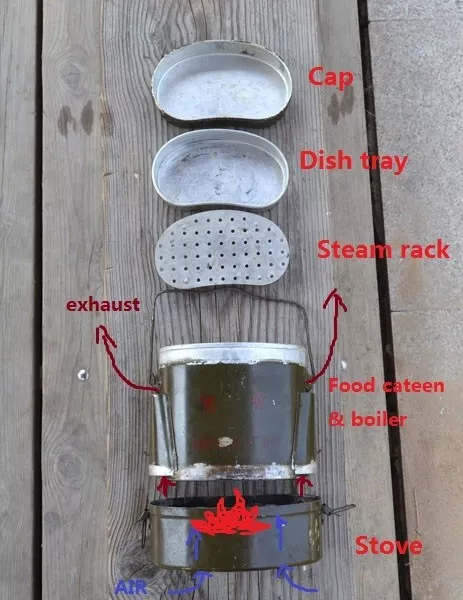
Shown about is an interesting Chinese-issue mess-tin with stove. The stove is not unlike the Crusader cup models, but clips to the bottom of the mess-tin for carriage. There are air holes drilled in the underside, and the mess-tin has two side channels as “exhausts”.
Improvements
As I have discussed in a previous blog, mess tins are not as widely used by the military as they once were. Many soldiers now make do with just a canteen cup. Most of us, however, do not enjoy the extensive logistical support most soldiers have.
One company is already offering a stainless steel copy of the Swedish mess kit, so I think there is a good case for commercial versions of the European style mess tins.
I think many of us would be interested in an aluminium version of the Swedish kit with a non-stick or hard anodized coating. Essentially, the same materials and finish as the Crusader Mk. II cup.
Some of us would probably prefer a Swedish mess kit that was a little more compact. On the other hand, I think there would also be potential users that want it a little bigger.
An improved version should probably be available in one litre and 1.5 litre variants. The most practical way to do this would be to have two billies which only differ in depth. All other components would be the same for both variants.
Features I like from the German mess kit are the measuring indents, the locking mechanism on the bail handle and the insert. An insert for the Swedish mess kit might be useful, particularly if available in alternate materials such as plastic.
The stove for the improved mess kit should be capable of taking several fuel types. For example, hexamine, alcohol gel and spirits. Something along the lines of a scaled up Crusader Mk II stove, perhaps.
